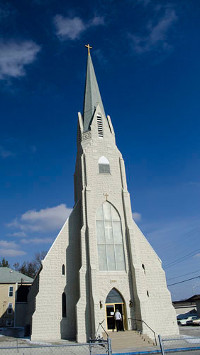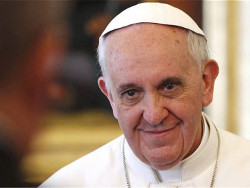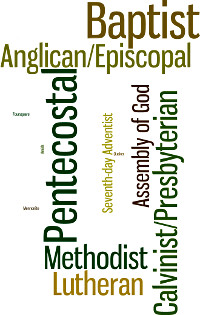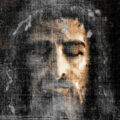
Last night before dusk, I was a few minutes early at church. A number of small children were leaving CCD (a/k/a religious education class) and posing for pictures in front of our patron saint’s statue while holding some formal-looking certificate. The children were proud of their accomplishment (whatever it was) and the parents were beaming.
What a happy place! If we think about it, we realize that all of the really important milestones of our lives take place right here at this building. Yet this building is quite different than every other. It is God’s house and He is at home.
This is where we come to unite with Him in His once and for all sacrifice which continues for us to this day. Here we join with Him both spiritually and incarnated in the Blessed Sacrament, the source and summit of the Christian life. It is not just the two of us either, but all the faithful: past, present and future. At this place our Eucharistic liturgy joins with the Heavenly liturgy, in the presence of God, together with all the angels and saints. If ever the word “awesome” could be applied, this is it.
The rhythm of our lives plays-out here. The picture taking I witnessed is just a memorable snapshot of a long series, in the lives of those children and in the lives of their parents. For each of them this journey began at their baptisms where they became the adopted children of God, establishing a familial relationship with Him and the entire Communion of Saints.
As the weeks and years pass, we live our imperfect lives, anchored by faith and our continuous response to the calls of conversion and holiness. In a world searching for the meaning of life, we found it — to know, love and serve the Lord. The truth really does set us free. Seeking to know Him, we serve the poor, connect to the disenfranchised, comfort the suffering, go to Bible studies, classes, men’s and women’s groups, retreats, read scripture and pray… most especially through our participation in the Most Holy Sacrifice of the Mass. It is there that the bridegroom and His bride the Church are most intimately one in their expression of mutual love. It is from there we are sent into the world to serve Him.
The timeline marches on but we are not afraid. Along the way we are continuously strengthened by the sanctifying grace of the sacraments. The young children in the pictures will soon receive first communion. A little later, they will be confirmed, with new graces complimenting their baptisms and further forming their office as priests, prophets and kings. In a few years, many will also enter into a life-long covenant with another through the sacrament of Holy Matrimony. It will be they who are then behind the camera taking pictures of their own children.
Along the way, our fallen nature allows us to choose against what is good, true and holy. We temporarily leave this place for one of false promises. Our rebellion may be brief or many decades. The Father waits patiently for us to return and the angels rejoice when we finally turn back. In the sacrament of Reconciliation, Jesus absolves and forgets our sins, throwing His loving arms around us and welcomes us home.
Eventually, the race will end. We will be gone, temporarily, from our body. Our loved ones will bring us here one last time as the cycle for us is completed. Later that day a new life may be brought into the Church, a couple may become one, or a brother or sister find their way back.
That is what happens here everyday in God’s house, this Catholic church and every Catholic church. We are so blessed.





















